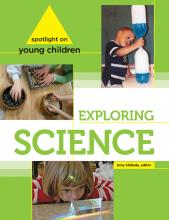Excerpt from Spotlight on Young Children: Exploring Science

by Peggy Ashbrook and Ingrid Chalufour
For all ages it is important for the teacher to encourage and support problem solving. The following classroom vignette illustrates both the content and process of science, as well as the essential relationship between experience and conversation.
Maria and Akil are busy at the water table. They try using a piece of clear tubing to move water from the water table to a plastic tub two feet away. The children experiment by adding water into the tube with a baster, a squirt bottle, and a funnel. They observe carefully, comparing how far each tool moves the water.
This class of 4-year-olds has been working with these materials for a few weeks, using forces—air pressure, water pressure, and gravity—to move water down, up, and sideways. Today they are investigating a question that grew out of their inquiry. How much and what kind of force will move water a longer distance? The teacher guides their preparation for this investigation by talking with them about what they want to try, how they might proceed, and what they think will happen. After trying each method, they draw a picture showing the results. The children will use their drawings to share their experiences and findings with the class.
With the purpose of gaining a better understanding of how forces move water, the children are posing questions, using tools, working collaboratively, making plans, predicting outcomes, observing closely, documenting results, and talking about their findings. They are using inquiry skills —and science and engineering practices—that they have learned in their preschool classroom. Through many experiences and conversations over weeks and months, Maria, Akil, and their classmates develop and refine their ideas about how force moves water. Guided by their teacher’s open-ended questions, the children share their observations as evidence that supports their evolving ideas.
In the vignette, the content of the children’s investigations includes some of the big ideas in physical science. Water, a liquid, is a form of matter that has characteristics that can be observed and described. These characteristics, along with forces that act on water, influence how water behaves in different circumstances. The children are deeply engaged in the process of inquiry, an evidence-based approach to studying the natural world that scientists use to explain the hows and whys of the world. Both content and process are essential aspects of children’s science learning.
One-time activities—a single exploration of materials or a demonstration by the teacher—have serious limitations. They deprive children of opportunities to actively engage in scientific inquiry and to collect and compare many related experiences over time in pursuit of new explanations or ideas. Not only do children learn science best through long-term investigations focusing on physical, life, earth, and other sciences, but when inquiry is a central focus of the curriculum, they learn literacy skills, social skills, and mathematics as well. Inquiry requires learners to use language to build a specialized vocabulary, talk about their experiences, and record their observations and ideas. Maria and Akil practice language and literacy skills as they design and document their investigation. Comparing the flow of water through their tube, they use mathematics to measure the distances. And they are working together on a common goal, which helps build social competence.
From Spotlight on Young Children: Exploring Science, edited by A. Shillady. Copyright © 2013 National Association for the Education of Young Children.
Learn more about this book
Resources
Recommendations
For Authors & Photographers
Catalog
Webinars
NAEYC Books List
